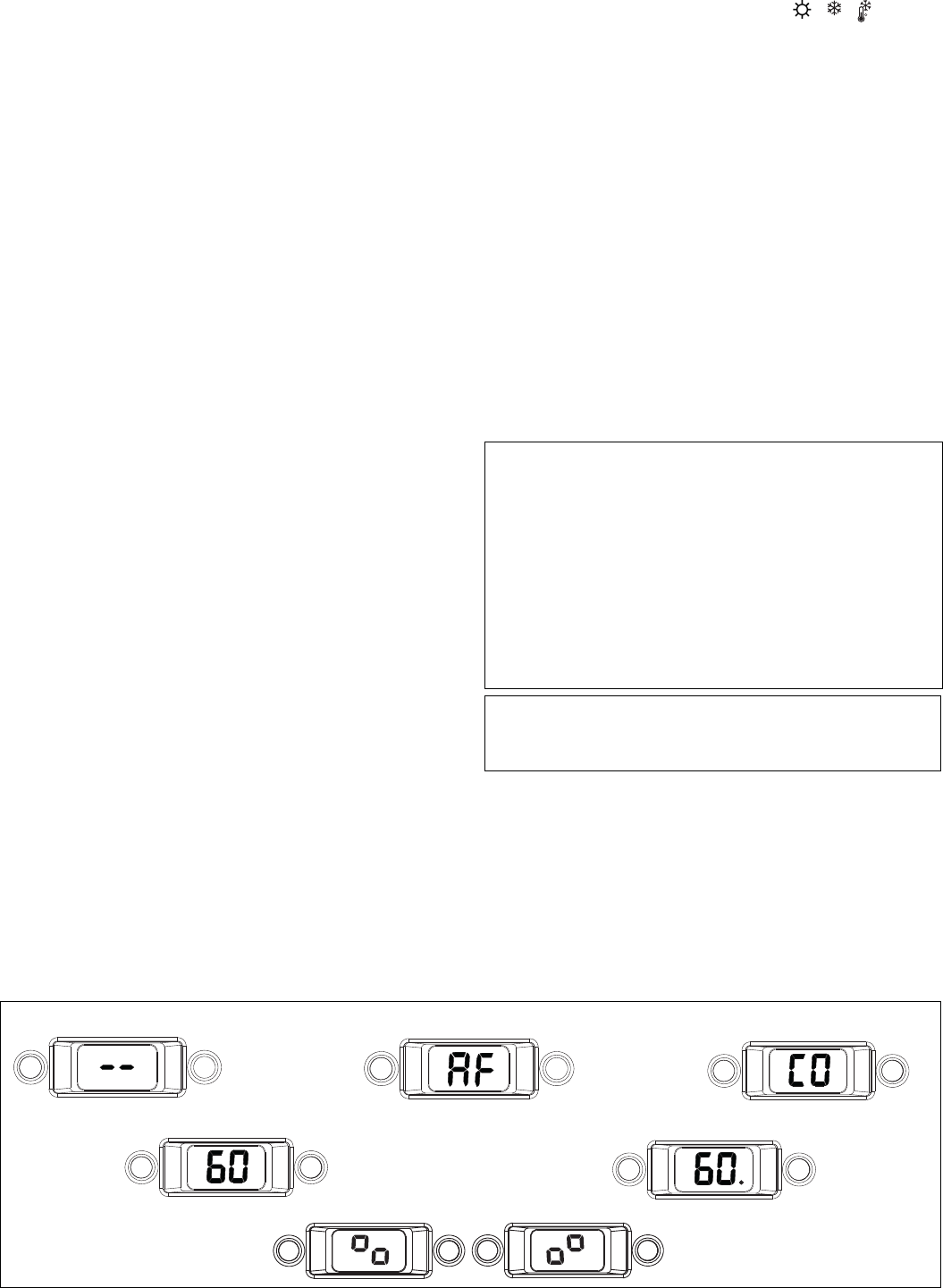
46
5. HEATING MODE
With the selector switch in the ON position (
- -
F
) and any
additional controls (time clock, programmer, room thermostat, etc,)
calling for heat, the appliance will operate in the heating mode. The
pump and fan will be activated via the flow temperature sensor.
When the fan is sensed to be operating correctly (blower signal),
the ignition sequence commences. Ignition is sensed by the
electronic circuitry to ensure flame stability at the burner. Once
successful ignition has been achieved, the electronic circuitry
increases the gas rate to 75% of the MAX Heating (set by the
corresponding HTG trimmer) for a period of 15 minutes. The speed
of the fan and therefore the output of the boiler is determined by
the temperature of the water sensed by the flow temperature
sensor, consequently a high temperature at the flow sensor results
in a lower fan speed. As the water temperature increases, the
temperature sensors – located on the flow pipe of the boiler –
reduce the fan speed via the electronic circuitry. Depending on
the load, either the water temperature will continue to rise until
the set point is achieved or the water temperature will fall whereby
fan speed will increase relative to the output required. When the
boiler has reached the set point (+ hysteresis), the burner will
switch off. The built-in anti-cycle device prevents the burner from
re-lighting for approximately 3-minutes. When the temperature
of the flow sensor falls below the set point (- hysteresis), the
burner will re-light.
NOTICE:
If the spark/sensing electrode does not sense
ignition the appliance will re-attempt ignition a further 4-times
then go to lockout. When the set-point has been reached
(the position of the heating temperature selector) as
measured at the primary thermistor, the appliance will begin
the modulation phase whereby the fan and gas valve will
continuously modulate to maintain the set-point.
If the temperature continues to rise and exceeds the set-
point by 9°F (5°C) (hysteresis), the burner will shut down. A
new ignition sequence will be enabled when the 3- minute
anti-cycle has been performed and the temperature at the
primary thermistor has dropped 9°F (5°C) (hysteresis) below
the set-point.
NOTICE: When the request for heating and/or hot water has
been satisfied, the appliance pump and fan may continue to
circulate to dissipate any residual heat within the appliance.
6. DHW MODE
With the selector switch in either the hot water only or heating &
hot water position, the appliance will operate in the hot water
mode whenever a tank sensor/thermostat is in request. If there is
a request the pump and fan will be activated via the flow tempe-
rature sensor. When the fan is sensed to be operating correctly
(blower signal), the ignition sequence commences. Ignition is
sensed by the electronic circuitry to ensure flame stability at the
burner. Once successful ignition has been achieved, the
electronic circuit allows the gas rate to achieve the modulation
value.
1. CHECKING APPLIANCE OPERATION
When carrying out any repairs or servicing to the appliance, the
relevant commissioning procedure must be undertaken to
ensure the continued safe operation of the appliance. Particular
attention should be made to ensure gas tightness, water
tightness, and the electrical integrity of the appliance.
2. APPLIANCE MODES OF OPERATION
NOTICE
There must be sufficient system water pressure min 7 psi (0.5 bar)
to ensure the water pressure switch is activated. If there is
insufficient system pressure the pump and fan will be prevented
from operating and the low-pressure fault code will be displayed.
The 2-digit display can show several different modes of
operation.
3. SELECTOR SWITCH IN THE OFF/STAND BY POSITION
When the selector switch is in the Off/reset position, the following
functions are active.
Active functions:
- Freeze protection system
- Pump anti-seize
4. ON-BOARD FUNCTIONS
-
THERMOREGULATION
: When an outdoor air sensor is
connected to the appliance, the electronic circuitry will
automatically adjust the flow outlet temperature to suit local
weather conditions in order to maintain comfort and efficiency. A
specific operating curve that is most suited to the system type
and geographical area can also be selected (Fig. 65).
-
CO FUNCTION
: the CO function when activated, will allow
the appliance to run at maximum and minimum output while a
combustion analysis check is being carried out. While the CO
function is active, all other functions are disabled (minimum
power operating period, anti-cycle, set-point, etc). Once
enabled, the CO function will remain active for a 15-minute
period, or until the function is manually deactivated (refit and
rotate in any direction the main selector switch).
- FREEZE PROTECTION:This function is only active when there
are no requests for heating or DHW. If the temperature drops
below 43°F (6°C), the boiler will operate on minimum power
until the temperature of the primary thermistor reaches 95°F
(35°C). Thereafter the pump & fan will post-purge for 30-seconds.
- ANTI-CYCLE FUNCTION: The anti-cycle function ensures
the burner remains switched off for at least 3-minutes after the
set-point hysteresis (set-point + 9°F (5°C)).
- PUMP ANTI-SEIZE FUNCTION: When there has been no
heating or DHW request for 24-hours, the anti-seize cycle is
activated. The pump will be activated for a period of 30-seconds.
- ACTUATOR ANTI-SEIZE FUNCTION: When there has been
no heating or DHW request for 24-hours, the anti-seize cycle is
activated. The divertor valve actuator (3-way valve) will cycle
briefly to the heating position, and then back to the DHW position.
11 - CHECKS, ADJUSTMENTS AND FAULT FINDING
Freeze protection mode active
Combustion analysis mode active
Normal heating request (example 140°F (60
o
C)).
Normal DHW request (example 140°F (60
o
C))
OFF/reset position
Fig. 58
Purge cycle mode active


















